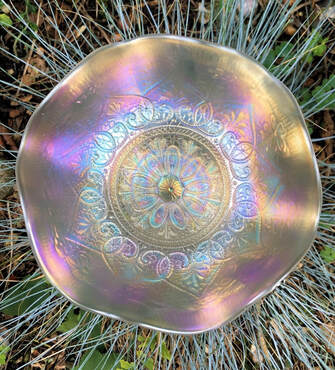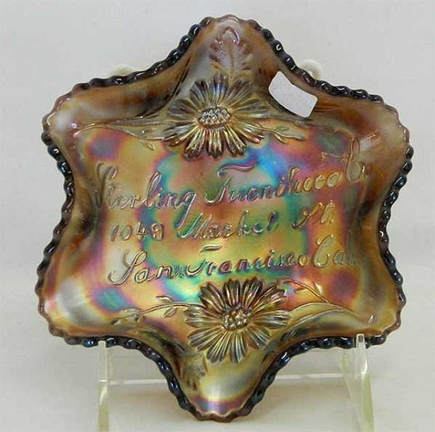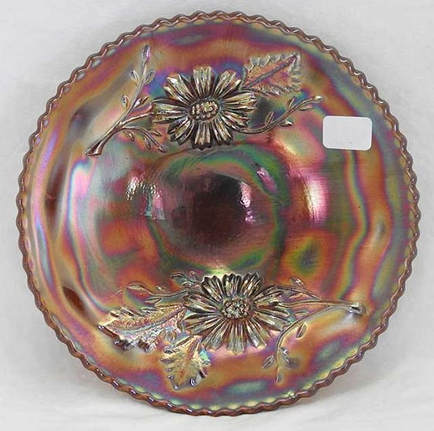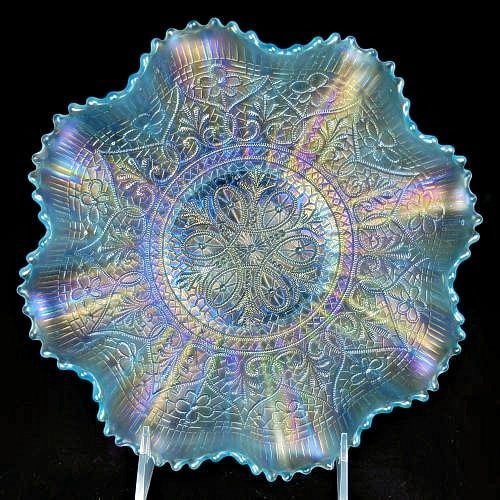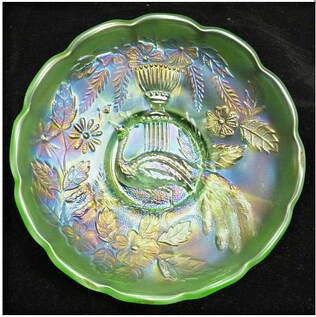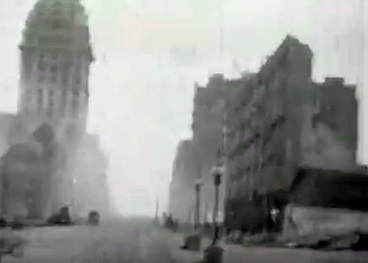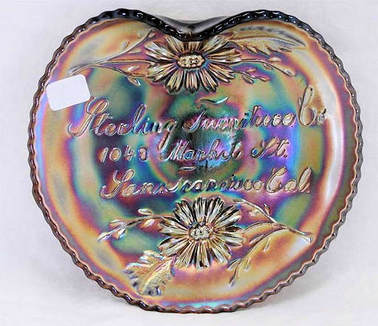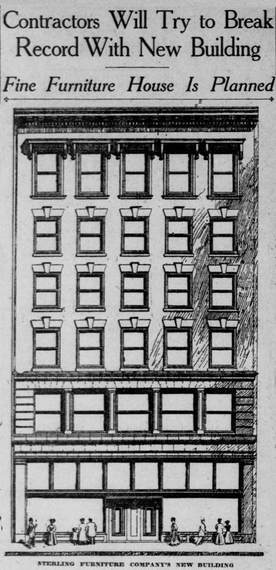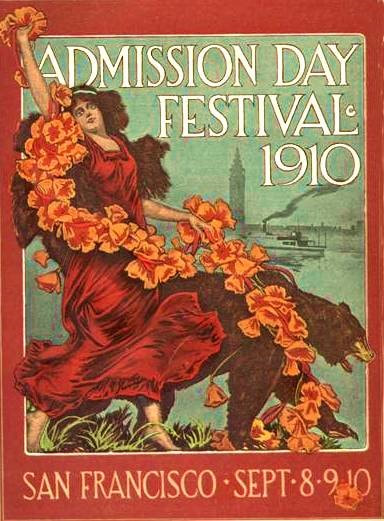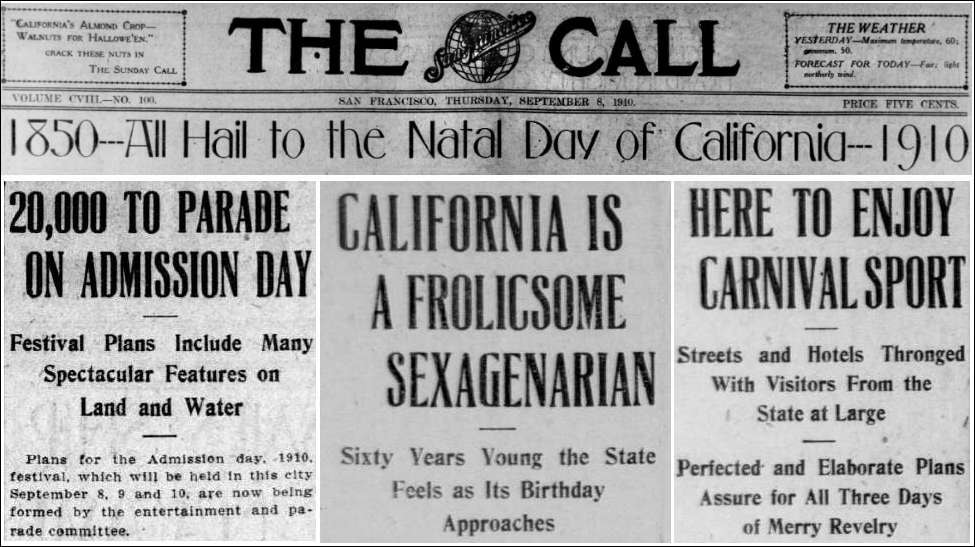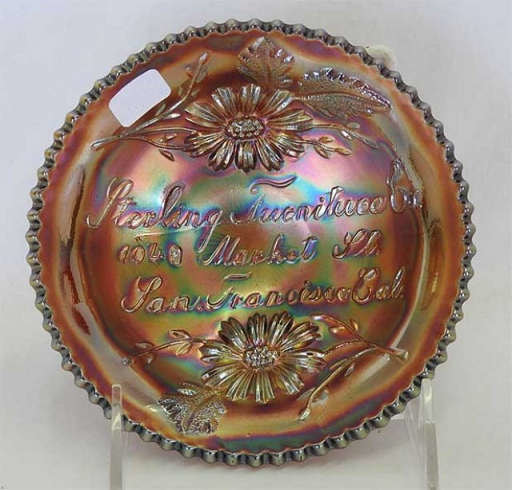Sterling Furniture (Fenton) - The Story Behind The Glass
Left: Sterling Furniture Advertising Piece - a ruffled bowl in amethyst, and on the right, is a Garden Mums "blank", a design that
Fenton used for several of their Advertising Pieces. Both pictures courtesy of Seeck Auctions.
Fenton used for several of their Advertising Pieces. Both pictures courtesy of Seeck Auctions.
On the left above is the Sterling Furniture Advertising Piece made by Fenton. It also has the address of the store - 1049 Market St., San Francisco, Cal.
The design utilises Fenton’s Garden Mums pattern, (which conveniently had a blank space in the centre), a design shared with several other advertising pieces, such as Geo W Getts Pianos and Exchange Bank. The pieces are around five to six inches in diameter and are only known in amethyst. There are four shapes which were all fashioned from the same mould - a ruffled bowl, a round bowl, a plate, and a handgrip plate.
John Resnik researched this company for his book "The Encyclopedia of Carnival Glass Lettered Pieces" published in 1989, which was—and still is—the only comprehensive study of lettered (and advertising) Carnival Glass. John unearthed information on this piece (and others) by research in the Public Libraries, and he found out that the Sterling Furniture business was started in Sacramento by Reason G. Davies, and then he expanded to San Francisco in the late 1800s. The first telephone listing for Sterling Furniture was 1900 and the company arrived at the 1049 Market Street address in 1910. The business moved to Daly City (Ca) in 1961, and from 1970 Sterling Furniture stopped retail selling and specialised in manufacture only.
|
Our subsequent research has revealed much more information, and we have a theory as to when and why the Carnival advertising piece was made. Sterling Furniture Begins Reason G. Davies was from a pioneering family that left Missouri in 1847 for the warm sun and fertile soils of California. He began the Sterling Furniture Company in Sacramento, then moved to San Francisco where he established the company in new premises at 1039 Market Street. Unfortunately it fell into serious debt and in 1896 was “absorbed” by the much bigger and successful California Furniture Company that was headed up by Nathaniel Palmer Cole. The newly amalgamated company continued to occupy the large premises at 1039 Market Street, probably due to the fact that it was an excellent location on the prime thoroughfare in the city. This was now the “face” of the company in a prime location. |
Cutting from the San Francisco Call newspaper, 1901.
Note the address is 1039 Market Street, and note also the typo “Compay” instead of “Company” (which continued for some months). |
|
A fascinating and truly remarkable nine minutes of film footage exists entitled “A Trip Down Market Street”, filmed around April 12th 1906, just before the disastrous earthquake and fire. It was recorded by a camera on the front of a cable car travelling down San Francisco’s Market Street, and it shows not only the buildings but also the transportation and the people. To say it is “remarkable” is possibly an understatement. It is like peering through time to actually see the city how it was right then. In the first few minutes of the film the camera would have passed by the Sterling Furniture building on the right, at 1039 Market Street, but it’s tricky to spot it for all the people, jay-walkers, automobiles, horses, carts and buggies! It’s amazing that we can peek back in time in such a fascinating manner. |
|
There is another YouTube video showing the horrendous damage. Here is the link: Market Street after the earthquake.
|
The brutal shock of this film footage is that four days later, at 5.12 a.m. on April 18th 1906, the Great San Francisco Earthquake struck, bringing death and destruction to the city. The cataclysm would reduce parts of Market Street to rubble. Sterling Furniture would suffer not only from the earthquake but also from the ensuing conflagration. Later, dynamite would finally bring down the dangerous parts of the Sterling Furniture building that remained. ‘Twas Like a Terrier Shaking a Rat" The day after the disaster, the Minneapolis Journal reported a University of California professor from the US geodetic survey describing his experience: “The earthquake came from north to south and the only description I am able to give of its effect to me is that it seemed like a terrier shaking a rat”. Over 80% of San Francisco was destroyed. The earthquake and resulting fire are remembered as one of the worst natural disasters in the history of the United States. Man’s ability to recover from disaster is truly amazing. “The rubble of what was once the heart of San Francisco had barely cooled before rebuilding began following the earthquake and fire. Some 11 million cubic yards of ruined brick and stone walls, twisted steel, and debris of all types had to be removed." |
"Temporary railroad tracks were laid on key streets in the city so that gondolas and ore carts to haul away the heavy chunks of stone, brick, and mortar that were being lifted from the wreckage by steam shovel and crane". (University of San Francisco www.usfca.edu/about/history/recovery_rebuilding/ ).
|
A New Address for Sterling Furniture
Sterling Furniture employed the architects James and Merritt Reid (the Reid Brothers) to design a new and better building on the same Market Street site. Note that the new building (soon to be called the Sterling Building) would then have a slightly different address - the one that is seen on the Fenton advertising piece - at 1049 Market Street. Within a year the new address was being advertised in the San Francisco directory; soon afterwards the newspapers would also carry Sterling Furniture ads with the new address on them. The San Francisco Call ran a feature on the building in its March 3rd 1907 issue (see right). The text below the image of Sterling Furniture’s new building noted that “the site chosen is the one occupied by the company before the fire. It is the desire of the management of the Sterling company to be installed in the new building as soon as possible. With this end in view the structure is to be erected in record breaking time”. So when and why was the Fenton Sterling Furniture Carnival Glass advertising piece made? A Sterling Furniture handgrip plate in amethyst. Courtesy of Seeck Auctions.
|
Could it have been in 1908 to promote the new building at the 1049 Market Street address? It’s possible, but we feel it is unlikely. The company would still have been mainly concerned with getting back on its feet after the earthquake at that point; the timing also seems a bit too soon for Fenton to have been offering the souvenir glassware. A year or two later seems much more likely - and this would tie in with known dates on lettered pieces. So, what could have been the stimulus around 1910?
California Admission Day Festival 1910
Our theory is that Sterling Furniture most likely commissioned Fenton to make the advertising pieces for them to coincide with the California Admission Day Festival that was hosted in San Francisco in September 1910. The festival was held to celebrate California’s admission to the Union on September 9th 1850.
By 1910, San Francisco had finished rebuilding after the devastating 1906 earthquake and fire and it was ready to rock and roll; ready to show everyone that it was back on the scene. And show them it did! The Festival was officially classed as a World’s Fair and it was intended to be the grandest that had ever been seen in California. Days of celebrations, parades, fireworks, regattas and more were planned by the Admission Day Festival Committee. Furthermore, prizes were to be awarded to the businessmen who decorated their buildings and stores in the most original and artistic manner.
California Admission Day Festival 1910
Our theory is that Sterling Furniture most likely commissioned Fenton to make the advertising pieces for them to coincide with the California Admission Day Festival that was hosted in San Francisco in September 1910. The festival was held to celebrate California’s admission to the Union on September 9th 1850.
By 1910, San Francisco had finished rebuilding after the devastating 1906 earthquake and fire and it was ready to rock and roll; ready to show everyone that it was back on the scene. And show them it did! The Festival was officially classed as a World’s Fair and it was intended to be the grandest that had ever been seen in California. Days of celebrations, parades, fireworks, regattas and more were planned by the Admission Day Festival Committee. Furthermore, prizes were to be awarded to the businessmen who decorated their buildings and stores in the most original and artistic manner.
|
On the left is one of the several official posters that were issued for the Admission Day Festival of 1910, and below are extracts from the 1910 San Francisco Call newspaper. The front page headline on Thursday September 8, 1910 heralded the Admission Day Festival, and various reports inside the paper give a flavour of how excited San Francisco was about the three days and nights of parades and pageants for what was being dubbed “California's birthday party.” |
Market Street was the main thoroughfare of the rebuilt San Francisco, so Sterling Furniture was situated right at the centre of the activities. The San Francisco Call reported in July 1910 that the “committee on decoration is busy on Market St …where experiments are being made for the general street decorations”. There were to be band concerts on Market Street too and special treatment with regard to new-fangled lighting was reported in August: “The scheme for the electrical illumination of Market Street is after the style of the arbour arches in Fillmore Street with 150 lights to each arch and a large globe lamp pendant from the center”.
A Golden Canopy of Electricity on Market Street
The main parade began on Market Street itself which was described variously in the newspapers as “a golden canopy of electricity” and “a brilliant avenue of flags and festoons”. The importance of the Market Street location was emphasised by the fact that two “moving picture” operators from New York were set up at vantage points there to film the three days of fabulous parades and pageants. “San Francisco is in Gala Attire” shouted the headlines in the papers.
On September 8th the Los Angeles Herald wrote: “Fifteen hundred red, green and yellow devils, each burning fire of his own will dart in and out of the long line of the Admission Day parade Saturday night, giving it the general admonitory aspect of a gargantuan illuminated serpent. For the first time in the history of carnival warfare a corps of artillery with mortars will discharge bombs at the crowds along the streets and explode to cover their targets with confetti.
A Golden Canopy of Electricity on Market Street
The main parade began on Market Street itself which was described variously in the newspapers as “a golden canopy of electricity” and “a brilliant avenue of flags and festoons”. The importance of the Market Street location was emphasised by the fact that two “moving picture” operators from New York were set up at vantage points there to film the three days of fabulous parades and pageants. “San Francisco is in Gala Attire” shouted the headlines in the papers.
On September 8th the Los Angeles Herald wrote: “Fifteen hundred red, green and yellow devils, each burning fire of his own will dart in and out of the long line of the Admission Day parade Saturday night, giving it the general admonitory aspect of a gargantuan illuminated serpent. For the first time in the history of carnival warfare a corps of artillery with mortars will discharge bombs at the crowds along the streets and explode to cover their targets with confetti.
|
The throngs lining the sidewalks will reply to the assaults of these invaders with volleys of confetti, serpentine papers and flowers, and the battle will never have a lull until the attacking parade is driven into the Auditorium at Page and Fillmore, where it will try to hold its own during the immense masquerade ball, where thousands of picturesquely garbed revelers will slaughter the hours that will mark the termination of the biggest revel ever held in California.” The San Francisco Call described the firework display on Market St. thus: “as the line of floats and merry makers advanced down Market St the boom of rockets sounded from Union Square and high in the air, higher than the tall buildings, higher even than the cheers of the throng, broke the fireworks, rockets that spangled the heavens with falling stars of red, gold, green and blue. Like a broad aerial Christmas tree, the colors formed in the sky, to burn their bright moment, and then fade. Another report, another boom and a graceful point of light would climb to the zenith and break into a cluster of falling stars.” And so that is why Sterling Furniture had a Carnival Glass piece made … There’s no doubt about it. The California Admission Day Festival in San Francisco, 1910 was big. And Market Street was right at the centre of the action, with Sterling Furniture being in a prime position. The celebrations had been planned for many, many months in advance, which would have given Sterling Furniture plenty of time to put an order with Fenton for their advertising pieces. Imagine how wonderful they would have looked as part of the window dressing for the festivities. And of course, “prizes were to be awarded to the businessmen who decorated their buildings and stores in the most original and artistic manner.” What would have been more “original and artistic” than a display of Carnival Glass items? And surely a “win win” as they were also promoting the store and would have been given away to customers. |
A Sterling Furniture round bowl in amethyst. Courtesy of Seeck Auctions
|
Interestingly, we know from contemporaneous ads that Sterling Furniture was also a seller of Carnival Glass - including Carnival made by Northwood!
See more Stories Behind The Glass
